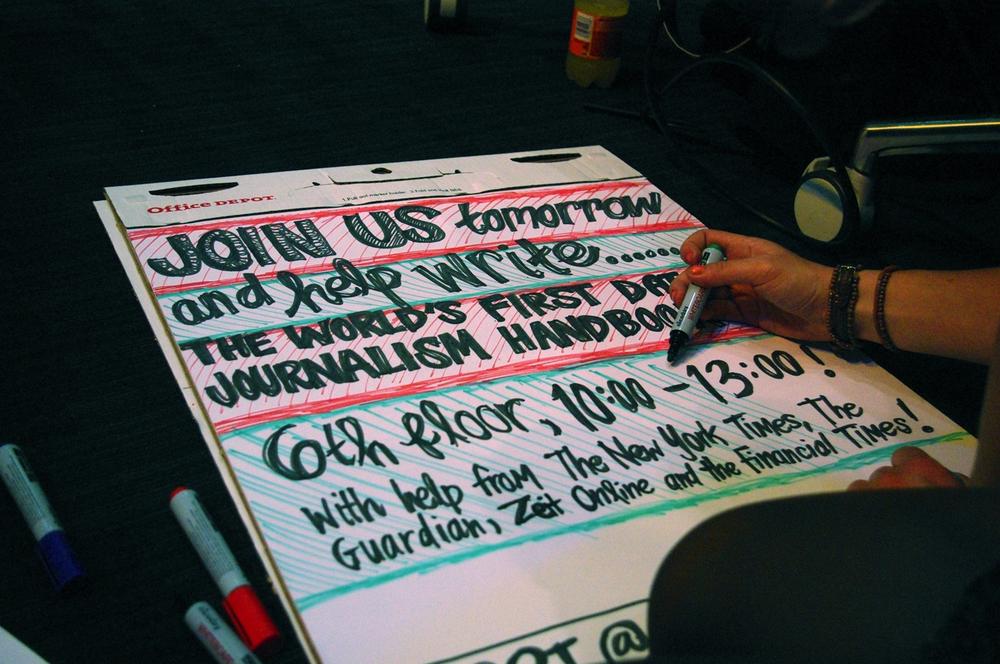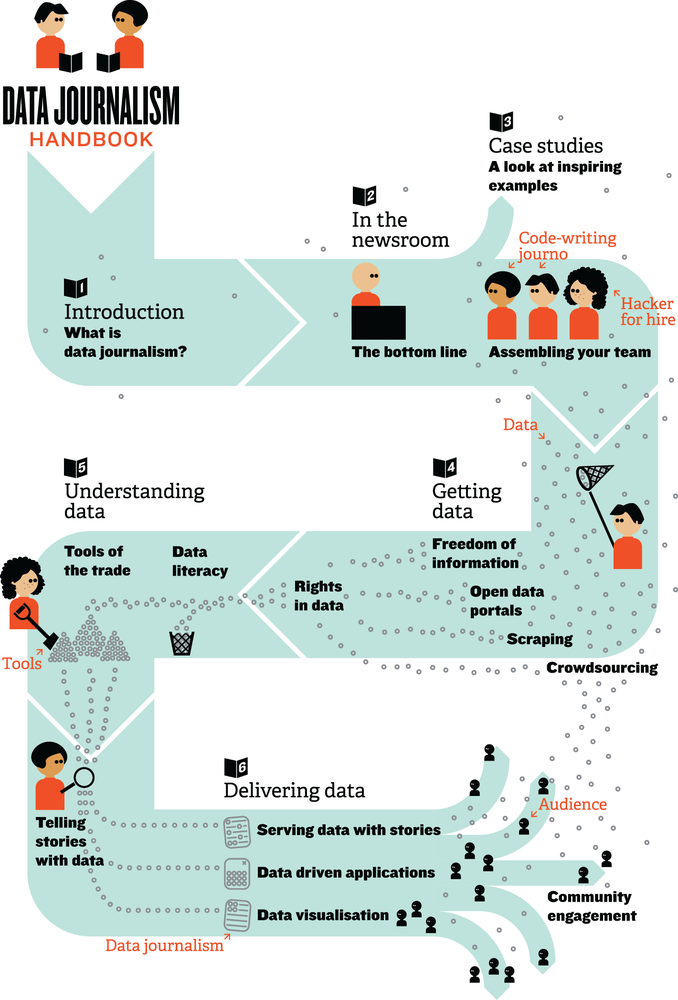The Data Journalism Handbook was born at a 48 hour workshop led by the European Journalism Centre and the Open Knowledge Foundation at MozFest 2011 in London. It subsequently spilled over into an international, collaborative effort involving dozens of data journalism’s leading advocates and best practitioners.
In the six months that passed between the book’s inception to its first full release, hundreds of people have contributed in various ways. While we have done our best to keep track of them all, we have had our fair share of anonymous, pseudonymous, and untraceable edits.
To all of those people who have contributed and are not listed below, we say two things. Firstly, thank you. Secondly, can you please tell us who you are so that we can give credit where credit is due?
The following people have drafted or otherwise directly contributed to text in the current version of the book (and illustrations are by graphic designer Kate Hudson):
- Gregor Aisch, Open Knowledge Foundation
- Brigitte Alfter, Journalismfund.eu
- David Anderton, Freelance Journalist
- James Ball, the Guardian
- Caelainn Barr, Citywire
- Mariana Berruezo, Hacks/Hackers Buenos Aires
- Michael Blastland, Freelance Journalist
- Mariano Blejman, Hacks/Hackers Buenos Aires
- John Bones, Verdens Gang
- Marianne Bouchart, Bloomberg News
- Liliana Bounegru, European Journalism Centre
- Brian Boyer, Chicago Tribune
- Paul Bradshaw, Birmingham City University
- Wendy Carlisle, Australian Broadcasting Corporation
- Lucy Chambers, Open Knowledge Foundation
- Sarah Cohen, Duke University
- Alastair Dant, the Guardian
- Helen Darbishire, Access Info Europe
- Chase Davis, Center for Investigative Reporting
- Steve Doig, Walter Cronkite School of Journalism, Arizona State University
- Lisa Evans, the Guardian
- Tom Fries, Bertelsmann Stiftung
- Duncan Geere, Wired UK
- Jack Gillum, Associated Press
- Jonathan Gray, Open Knowledge Foundation
- Alex Howard, O’Reilly Media
- Bella Hurrell, BBC
- Nicolas Kayser-Bril, Journalism++
- John Keefe, WNYC
- Scott Klein, ProPublica
- Alexandre Léchenet, Le Monde
- Mark Lee Hunter, INSEAD
- Andrew Leimdorfer, BBC
- Friedrich Lindenberg, Open Knowledge Foundation
- Mike Linksvayer, Creative Commons
- Mirko Lorenz, Deutsche Welle
- Esa Mäkinen, Helsingin Sanomat
- Pedro Markun, Transparência Hacker
- Isao Matsunami, Tokyo Shimbun
- Lorenz Matzat, OpenDataCity
- Geoff McGhee, Stanford University
- Philip Meyer, Professor Emeritus, University of North Carolina at Chapel Hill
- Claire Miller, WalesOnline
- Cynthia O’Murchu, Financial Times
- Oluseun Onigbinde, BudgIT
- Djordje Padejski, Knight Journalism Fellow, Stanford University
- Jane Park, Creative Commons
- Angélica Peralta Ramos, La Nacion (Argentina)
- Cheryl Phillips, The Seattle Times
- Aron Pilhofer, New York Times
- Lulu Pinney, Freelance Infographic Designer
- Paul Radu, Organised Crime and Corruption Reporting Project
- Simon Rogers, the Guardian
- Martin Rosenbaum, BBC
- Amanda Rossi, Friends of Januária
- Martin Sarsale, Hacks/Hackers Buenos Aires
- Fabrizio Scrollini, London School of Economics and Political Science
- Sarah Slobin, Wall Street Journal
- Sergio Sorin, Hacks/Hackers Buenos Aires
- Jonathan Stray, The Overview Project
- Brian Suda, (optional.is)
- Chris Taggart, OpenCorporates
- Jer Thorp, The New York Times R&D Group
- Andy Tow, Hacks/Hackers Buenos Aires
- Luk N. Van Wassenhove, INSEAD
- Sascha Venohr, Zeit Online
- Jerry Vermanen, NU.nl
- César Viana, University of Goiás
- Farida Vis, University of Leicester
- Pete Warden, Independent Data Analyst and Developer
- Chrys Wu, Hacks/Hackers
This book is intended to be a useful resource for anyone who thinks that they might be interested in becoming a data journalist—or just dabbling in data journalism.
Lots of people have contributed to writing it, and through our editing we have tried to let their different voices and views shine through. We hope that it reads like a rich and informative conversation about what data journalism is, why it is important, and how to do it.
Lamentably, the act of reading this book will not supply you with a comprehensive repertoire of all the knowledge and skills you need to become a data journalist. This would require a vast library manned by hundreds of experts able to answer questions on hundreds of topics. Luckily this library exists; it is called the Internet. Instead, we hope this book will give you a sense of how to get started and where to look if you want to go further. Examples and tutorials serve to be illustrative rather than exhaustive.
We count ourselves very lucky to have had so much time, energy, and patience from all of our contributors and have tried our best to use this wisely. We hope that—in addition to being a useful reference source—the book does something to document the passion and enthusiasm, the vision and energy of a nascent movement. The book attempts to give you a sense of what happens behind the scenes, the stories behind the stories.
The Data Journalism Handbook is a work in progress. If you think there is anything which needs to be amended or is conspicuously absent, then please flag it for inclusion in the next version. It is also freely available under a Creative Commons Attribution-ShareAlike license at www.datajournalismhandbook.org, and we strongly encourage you to share it with anyone that you think might be interested in reading it.
— Jonathan Gray, Open Knowledge Foundation (@jwyg), Liliana Bounegru, European Journalism Centre (@bb_liliana), and Lucy Chambers, Open Knowledge Foundation (@lucyfedia), March 2012
The following typographical conventions are used in this book:
- Italic
- Indicates new terms, URLs, email addresses, filenames, and file extensions.
Tip
This icon signifies a tip, suggestion, or general note.
Warning
This icon indicates a warning or caution.
Note
Safari Books Online is an on-demand digital library that delivers expert content in both book and video form from the world’s leading authors in technology and business.
Technology professionals, software developers, web designers, and business and creative professionals use Safari Books Online as their primary resource for research, problem solving, learning, and certification training.
Safari Books Online offers a range of product mixes and pricing programs for organizations, government agencies, and individuals. Subscribers have access to thousands of books, training videos, and prepublication manuscripts in one fully searchable database from publishers like O’Reilly Media, Prentice Hall Professional, Addison-Wesley Professional, Microsoft Press, Sams, Que, Peachpit Press, Focal Press, Cisco Press, John Wiley & Sons, Syngress, Morgan Kaufmann, IBM Redbooks, Packt, Adobe Press, FT Press, Apress, Manning, New Riders, McGraw-Hill, Jones & Bartlett, Course Technology, and dozens more. For more information about Safari Books Online, please visit us online.
Please address comments and questions concerning this book to the publisher:
| O’Reilly Media, Inc. |
| 1005 Gravenstein Highway North |
| Sebastopol, CA 95472 |
| 800-998-9938 (in the United States or Canada) |
| 707-829-0515 (international or local) |
| 707-829-0104 (fax) |
We have a web page for this book, where we list errata, examples, and any additional information. You can access this page at:
http://oreil.ly/data-journalism-handbook
To comment or ask technical questions about this book, send email to:
For more information about our books, courses, conferences, and news, see our website at http://www.oreilly.com.
Find us on Facebook: http://facebook.com/oreilly
Follow us on Twitter: http://twitter.com/oreillymedia
Watch us on YouTube: http://www.youtube.com/oreillymedia
Get The Data Journalism Handbook now with the O’Reilly learning platform.
O’Reilly members experience books, live events, courses curated by job role, and more from O’Reilly and nearly 200 top publishers.



